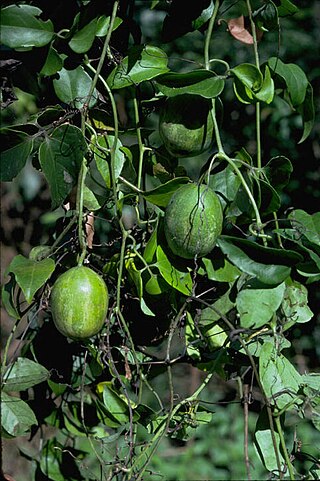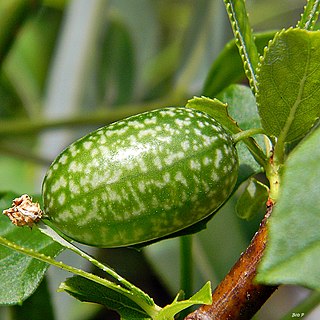
The Cucurbitaceae, also called cucurbits or the gourd family, are a plant family consisting of about 965 species in around 95 genera. Those most important to humans are the following:

A vine is any plant with a growth habit of trailing or scandent stems, lianas, or runners. The word vine can also refer to such stems or runners themselves, for instance, when used in wicker work.

Gourds include the fruits of some flowering plant species in the family Cucurbitaceae, particularly Cucurbita and Lagenaria. The term refers to a number of species and subspecies, many with hard shells, and some without. One of the earliest domesticated types of plants, subspecies of the bottle gourd, Lagenaria siceraria, have been discovered in archaeological sites dating from as early as 13,000 BCE. Gourds have had numerous uses throughout history, including as tools, musical instruments, objects of art, film, and food.

Cucurbita is a genus of herbaceous fruits in the gourd family, Cucurbitaceae, native to the Andes and Mesoamerica. Five edible species are grown and consumed for their flesh and seeds. They are variously known as squash, pumpkin, or gourd, depending on species, variety, and local parlance. Other kinds of gourd, also called bottle-gourds, are native to Africa and belong to the genus Lagenaria, which is in the same family and subfamily as Cucurbita, but in a different tribe. These other gourds are used as utensils or vessels, and their young fruits are eaten much like those of the Cucurbita species.

The cucumber is a widely-cultivated creeping vine plant in the family Cucurbitaceae that bears cylindrical to spherical fruits, which are used as culinary vegetables. Considered an annual plant, there are three main types of cucumber—slicing, pickling, and seedless—within which several cultivars have been created. The cucumber originates in Asia extending from India, Nepal, Bangladesh, China, and Northern Thailand, but now grows on most continents, and many different types of cucumber are grown commercially and traded on the global market. In North America, the term wild cucumber refers to plants in the genera Echinocystis and Marah, though the two are not closely related.

Cucumis is a genus of twining, tendril-bearing plants in the family Cucurbitaceae which includes the cucumber, true melons, the horned melon, and the West Indian gherkin.

Lagenaria is a genus of gourd-bearing vines in the squash family (Cucurbitaceae). Lagenaria contains six species, all of which are indigenous to tropical Africa. The best-known species, the calabash or bottle gourd, L. siceraria, has been domesticated by humans, and has spread beyond Africa. The other species are not cultivated. The gourds of the various species may be harvested young and used as a vegetable. More commonly, the gourds are harvested mature, then dried, and used in making utensils. Gourds of L. siceraria have been used to store water and other liquids since ancient times. The generic name lagenaria comes from classical Latin lagena meaning bottle or flask, plus Latin suffix -aria.

Nothoalsomitra suberosa is a species of subtropical vines in the family Cucurbitaceae, the only member of the monotypic genus Nothoalsomitra. Native to Queensland in Australia.

Citrullus ecirrhosus, commonly known as Namib tsamma, is a species of perennial desert vine in the gourd family, Cucurbitaceae, and a relative of the widely consumed watermelon. It can be found in both Namibia and the Cape Provinces of South Africa, in particular the Namib Desert. It is the sister species to the bitter melon, Citrullus amarus with which it shares hard, white and bitter flesh.

Melothria scabra, commonly known as the cucamelon, Mexican miniature watermelon, Mexican sour cucumber, Mexican sour gherkin, mouse melon, or pepquinos, is a species of flowering plant in the cucurbit family grown for its edible fruit. Its native range spans Mexico to Venezuela. Cucumis melo Agrestis and Cucumis callosus is cultivated as Chibber Fruit or Kachri in South Asia and can also grow as weed. Fruits are about the size of grapes and taste like cucumbers with a tinge of sourness. It may have been eaten by indigenous peoples before the European colonization of the Americas began.

Telfairia is a small genus of flowering plants in the squash family which are native to Africa. They include Telfairia occidentalis, the fluted pumpkin, which is an important vegetable in Nigeria and other African nations. It is also known as the oyster nut, a common name it shares with its relative Telfairia pedata. These are woody and herbaceous dioecious vines which bear squashlike fruits that contain large, nutritious oily seeds. The third species is Telfairia batesii which is very rare and not cultivated.

Luffa acutangula is a cucurbitaceous vine that is commercially grown for its unripe fruits as a vegetable. Mature fruits are used as natural cleaning sponges. Its fruit slightly resembles a cucumber or zucchini with ridges. It is native to South Asia and has been naturalised in other regions. It is also grown as a houseplant in places with colder climates. English common names include angled luffa, Chinese okra, dish cloth gourd, ridged gourd, sponge gourd, vegetable gourd, strainer vine, ribbed loofah, silky gourd, silk gourd,

Alsomitra is a genus of the plant family Cucurbitaceae.

Zehneria is a genus of flowering plants – of vines in the cucumber and gourd family, Cucurbitaceae. It contains about 35 species ranging from Africa, through Southeast Asia to Australia and Oceania. The name honours botanical artist Joseph Zehner.
Tumamoca macdougalii Rose is a member of the Cucurbitaceae or gourd family. Also called the Tumamoc globeberry, it is native to a very narrow area of the Sonoran Desert, and is found in both Sonora and Arizona. It is one of two species in genus Tumamoca.

Fevillea cordifolia, also known as javillo and antidote caccoon, is a climbing vine of up to 20 m of the family Cucurbitaceae and occurring in South and Central America in Bolivia, Brasil, Colombia, Costa Rica, Ecuador, Nicaragua, Panama, Peru and Venezuela.

Melothria is a genus of flowering plants in the family Cucurbitaceae, native to the Americas from the United States to Argentina, and with some introductions in Africa and elsewhere. A number of Old World species formerly in Melothria were reassigned to Cucumis.

Echinopepon is a genus of flowering plants in the family Cucurbitaceae, native to the southwestern United States, Mexico, Central America, and South America. Tendrillate vines, their prickly fruits are operculate, with the prickles themselves being stipitate glandular.
Cucumis hystrix is a monoecious annual climbing vine in the family Cucurbitaceae. The specific epithet is Neo-Latin for "porcupine".

















